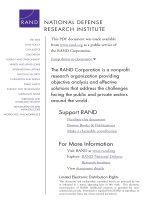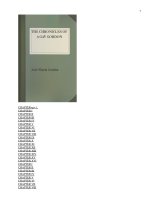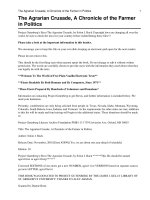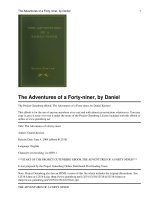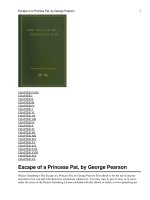Heterogeneous echogenicity of the underlying thyroid parenchyma: How does this affect the analysis of a thyroid nodule
Bạn đang xem bản rút gọn của tài liệu. Xem và tải ngay bản đầy đủ của tài liệu tại đây (639.6 KB, 9 trang )
Park et al. BMC Cancer 2013, 13:550
/>
RESEARCH ARTICLE
Open Access
Heterogeneous echogenicity of the underlying
thyroid parenchyma: how does this affect the
analysis of a thyroid nodule?
Mina Park1, So Hee Park1, Eun-Kyung Kim1, Jung Hyun Yoon1, Hee Jung Moon1, Hye Sun Lee2
and Jin Young Kwak1*
Abstract
Background: Heterogeneous echogenicity of the thyroid gland has been associated with diffuse thyroid disease
and benign and malignant nodules can coexist with diffuse thyroid disease. Underlying heterogeneous
echogenicity might make it difficult to differentiate between benign and malignant nodules on US. Thus, the aim
of this study was to evaluate the influence of underlying thyroid echogenicity on diagnosis of thyroid malignancies
using US.
Methods: A total of 1,373 patients who underwent US-guided fine needle aspiration of 1,449 thyroid nodules from
June 2009 to August 2009 were included. The diagnostic performance of US assessment for thyroid nodules was
calculated and compared according to underlying thyroid echogenicity. The diagnostic performance of US assessments in the diagnosis of thyroid malignancy according to the underlying parenchymal echogenicity was compared using a logistic regression with the GEE (generalized estimating equation) method. Each US feature of
malignant and benign thyroid nodules was analyzed according to underlying echogenicity to evaluate which feature affected the final diagnosis.
Results: Among the 1,449 nodules, 325 (22.4%) were malignant and 1,124 (77.6%) were benign. Thyroid glands
with heterogeneous echogenicity showed significantly lower specificity, PPV, and accuracy compared to thyroid
glands with homogeneous echogenicity, 76.3% to 83.7%, 48.7% to 60.9%, and 77.6% to 84.4%, respectively (P = 0.009,
0.02 and 0.005, respectively). In benign thyroid nodules, microlobulated or irregular margins were more frequently seen
in thyroid glands with heterogeneous echogenicity than in those with homogenous echogenicity (P < 0.001).
Conclusion: Heterogeneous echogenicity of the thyroid gland significantly lowers the specificity, PPV, and accuracy of
US in the differentiation of thyroid nodules. Therefore, caution is required during evaluation of thyroid nodules
detected in thyroid parenchyma showing heterogeneous echogenicity.
Keywords: Ultrasonography, Thyroid gland, Diffuse thyroid disease, Thyroid malignancy, Thyroid nodule
Background
Heterogeneous echogenicity of the thyroid gland has been
associated with diffuse thyroid disease (DTD) including
Hashimoto thyroiditis (HT) and Graves’ disease [1-4].
Ultrasonographic (US) features of HT have been reported
to show a broad spectrum of abnormal features ranging
* Correspondence:
1
Department of Radiology, Research Institute of Radiological Science, Yonsei
University, College of Medicine, 50 Yonsei-ro, Seodaemun-gu, Seoul 120-752,
South Korea
Full list of author information is available at the end of the article
from focal ill-defined hypoechoic areas to diffuse homogeneous hypoechoic regions showing areas of internal
echogenic fibrous septa or diffuse heterogeneous hypoechogenicity showing micronodular patterns [1-4].
Benign and malignant nodules can coexist with DTD
[5,6]. In particular, the association between HT and papillary thyroid carcinoma (PTC) has been reported in many
studies [5,7-9]. Although US features of malignant thyroid
nodules with diffuse HT have been reported to be similar
to typical malignant US features [10], underlying heterogeneous echogenicity might make it difficult to differentiate
© 2013 Park et al.; licensee BioMed Central Ltd. This is an open access article distributed under the terms of the Creative
Commons Attribution License ( which permits unrestricted use, distribution, and
reproduction in any medium, provided the original work is properly cited.
Park et al. BMC Cancer 2013, 13:550
/>
between benign and malignant nodules. Besides these
considerations, there are no published reports on this
topic: Does underlying thyroid parenchyma echogenicity affect the analysis of a thyroid nodule? If it does,
what are the associated US features impacting the analysis of a thyroid nodule?
This study investigated the influence of underlying thyroid echogenicity on the diagnosis of thyroid malignancies.
Methods
This retrospective study was approved by the institutional
review board (IRB) and ethics committee of Severance
hospital, Seoul, Korea. Neither patient approval nor
informed consent was required for review of medical
records or images. Informed consent was signed and
obtained from all patients before US-FNA or surgery
prior to procedures as a daily practice.
Between June 2009 and August 2009, there were 1,534
consecutive patients with 1,632 thyroid nodules who
underwent US-guided fine needle aspiration (US-FNA)
on focal thyroid nodules larger than 5 mm in our institution (a referral center) in Korea. Among them, we
retrospectively enrolled 1,373 patients with 1,449 thyroid
nodules, from whom we could obtain cytopathologic
results and follow-up data (Figure 1). There were 3 patients who underwent US-FNAs at 3 nodules, 70 patients
who underwent US-FNAs at 2 nodules, and 1300 patients
who underwent US-FNAs at 1 nodule. The mean age of
patients included was 50.8 years (range, 15–95 years).
Among the 1,373 patients, 1,126 were women (mean age,
50.5 years, range, 15–95 years) and 247 were men (mean
age, 52.1 years, range, 25–80 years).
Figure 1 Diagram of the study group. *Exclusion criteria in the result.
Page 2 of 9
US and US-FNA
US examinations and US-FNA were performed by one
of seven board-certified radiologists with 1 to 15 years of
experience in thyroid imaging, using a 7- to 15- MHz
linear probe (HDI 5000, Philips-Advanced Technology
Laboratories, Bothell, WA, USA) or a 5- to 12- MHz
linear probe (iU22, Philips-Advanced Technology Laboratories, Bothell, WA, USA). Compound imaging was performed for all US examinations. US features of the
underlying thyroid parenchyma and thyroid nodule
targeted for US-FNA were assessed at the time of US
examination and US-FNA. Diffuse echogenicity of the
thyroid parenchyma showing numerous micronodular
appearances or echogenic septations was defined as ‘heterogeneous echogenicity’ of the thyroid gland [6,11,12].
Thyroid nodules were classified according to internal
component, echogenicity, margin, calcification, and
shape on US. Marked hypoechogenicity, microlobulated
or irregular margins, microcalcifications, and taller than
wide shape were considered suspicious malignant features of thyroid nodules on US (Figure 2) [13]. When
thyroid nodules had one or more of the previously mentioned suspicious malignant US features, they were classified as “positive US”. When the thyroid nodules
showed no suspicious malignant features, they were
classified as “negative US”. After US, each US feature
was recorded by the radiologists who performed the US
on provided result sheets including the underlying
echogenicity of the thyroid gland on US.
At our institution, we do not routinely undergo FNA
at thyroid nodules less than 5 mm. The US-FNAs were
performed either on the thyroid nodule with suspicious
US features or on the largest thyroid nodule if no suspicious US features were detected. However, FNAs were
sometimes performed on multiple nodules in one patient
because of multiple suspicious US features, physician’s
or patient’s request. US-FNAs were performed using a
freehand biopsy technique with a 23-gauge needle attached to a 2-ml disposable plastic syringe. Each lesion
was aspirated at least twice. Aspirated material was expelled onto glass slides that were immediately placed in
95% alcohol for Papanicolaou staining. The remaining
aspirated material in the syringe was rinsed with saline
and processed for cell block preparation. Five experienced cytopathologists interpreted the cytology slides. In
the study period, cytological reports were classified as
(a) benign, (b) indeterminate, (c) suspicious for papillary
thyroid carcinoma, (d) malignant, or (e) nondiagnostic.
Among cases with benign cytology, lymphocytic thyroiditis was further diagnosed when the cytological specimen met the following criteria: the specimen showed
grouped, monolayer sheets or scattered follicular and
Hurthle cells with scattered lymphocytes; the colloid was
scanty; and the follicular cells showed nuclear atypia with
Park et al. BMC Cancer 2013, 13:550
/>
Page 3 of 9
Figure 2 US findings of a malignant thyroid nodule in underlying homogenous thyroid echogenicity. (a) Transverse and (b) longitudinal
US showed a 6-mm irregular, taller than wide nodule (arrows) with homogenous echogenicity of the underlying thyroid gland in the right thyroid
gland. The lesion was diagnosed as papillary microcarcinoma on surgical histopathology.
nuclear enlargement and clearing in the absence of
nuclear grooves or inclusions [14]. A non-diagnostic cytology result was defined as the presence of less than six
groups of cells, each containing at least ten cells [15,16].
Indeterminate cytology included follicular or Hurthle
cell neoplasm. The “suspicious for papillary carcinoma”
cytological result was designated when the specimen exhibited cytological atypia (nuclei are crowded and overlapping, enlarged, and pleomorphic) but showed insufficient
cellularity for definite diagnosis of papillary carcinoma
[17]. For this study, we recorded the results by retrospectively reviewing the cytological reports.
Measurement of serum anti-thyroid autoantibodies
Anti-thyroid antibodies were evaluated using venous blood
samples from 938 patients. Serum thyroid peroxidase
antibody (TPOAb), thyroglobulin antibody (TgAb) and
TSH-binding inhibitory immunoglobulins (TBII) levels were
measured by radioimmunoassay (Brahms, Hennigsdorf/
Berlin, Germany). The existence of TPOAb and/or TgAb
was defined by a serum concentration of the relevant
thyroid autoantibody > 60 IU/L. Patients with HT were
defined by positive results for TPOAb and/or TgAb [18].
A TBII exceeding 10% was considered positive. Patients
with Graves’ disease were defined as positive for TBII.
in the diagnosis of thyroid malignancy according to the
underlying parenchymal echogenicity was compared using
a logistic regression with the GEE (generalized estimating
equation) method. We considered P-values less than
0.05 statistically significant. Statistical analysis was performed using commercial statistical software (SAS version
9.1, SAS Inc., Cary, NC, USA).
Results
We retrospectively enrolled 1,632 thyroid nodules from
1,534 patients, from whom we could obtain cytologic
results. We excluded 125 nodules with non-diagnostic
results of FNA, 16 nodules with atypical follicular epithelial cells, 2 nodules with results of parathyroid cells
and lymph nodes, and 40 nodules without US findings
available. Among the 1,449 nodules, 325 (22.4%) were
malignant and 1,124 (77.6%) were benign (Figure 1).
Histopathologic diagnoses of the 315 thyroid nodules
are listed in Table 1. Patients (51.6 ± 11.8 years) diagnosed
with benign nodules were significantly older than those
Table 1 Histopathologic diagnosis of 315 thyroid nodules
Final pathology
Papillary carcinoma, conventional
Statistical analysis
Histopathology results from surgery or US-FNA cytology
were considered the standard reference of thyroid nodules. Statistical comparisons were performed using the
Chi-square test for categorical variables and independent
t-test for continuous variables. The diagnostic performance of US assessments of thyroid nodules according to
the echogenicity of underlying thyroid parenchyma was
calculated, including sensitivity, specificity, positive predictive value (PPV), negative predictive value (NPV), and
accuracy. The diagnostic performance of US assessments
n (%)
Malignant (n = 306, 97.1%)
Papillary carcinoma, follicular variant
264 (86.3)
29 (9.5)
Papillary carcinoma, diffuse sclerosing variant
5 (1.6)
Papillary carcinoma, oncocytic variant
3 (1.0)
Medullary carcinoma
3 (1.0)
Follicular carcinoma
1 (0.3)
Hűrthle cell carcinoma
1 (0.3)
Benign (n = 9, 2.9%)
Adenomatous hyperplasia
8 (88.9)
Hyalinizing trabecular adenoma
1 (11.1)
Park et al. BMC Cancer 2013, 13:550
/>
Page 4 of 9
(47.8 ± 12.6 years) diagnosed with malignant nodules
(P < .001). The mean size of the benign nodules were
16.6 ± 10.5 mm, which was significantly larger than that of
the malignant nodules, 11.8 ± 8.6 mm (P < .001). Gender
was not associated with malignancy (P = 0.954).
The mean age (52.3 ± 12.4 years) of the patients with
underlying heterogeneous echogenicity of the thyroid gland
was older than that (50.4 ± 12 years) of the patients with
underlying homogeneous thyroid echogenicity (P = 0.015).
In the underlying heterogeneous echogenicity group, 270
were women and 28 were men while in the underlying
homogenous echogenicity group, 856 were female and
219 were male, exhibiting female predominancy in the
underlying heterogeneous echogenicity group (P < .001).
The mean size (15.6 ± 10.5 mm) of the nodules in the
underlying homogenous echogenicity group was larger
than that (14.7 ± 9.2 mm) of underlying heterogeneous
echogenicity group, but it was not statistically significant (P = 0.119).
Of the 1,449 nodules included, 317 (21.9%) showed
underlying heterogeneous echogenicity of the thyroid
parenchyma on US. Table 2 shows the diagnostic performance of US in the differential diagnosis of thyroid
nodules, comparing the two groups with and without
underlying heterogeneous echogenicity of the thyroid
parenchyma on US. The thyroid nodules in a thyroid gland
with heterogeneous echogenicity had a significantly lower
specificity, PPV and accuracy compared to those with
homogeneous echogenicity. There were no significant
differences in sensitivity and NPV between the two groups.
To document the reason for different diagnostic performances of US according to the echogenicity of the thyroid
parenchyma, we analyzed each US feature by the malignant
and benign thyroid group according to the underlying
echogenicity of the thyroid gland (Table 3). In benign
thyroid nodules, microlobulated or irregular margins on
US were more frequently seen in nodules in a thyroid
gland with heterogeneous echogenicity than in those
with homogenous echogenicity (P < 0.001) (Figure 3).
On the other hand, in malignant thyroid nodules, there
Table 2 Diagnostic performance of US assessment in
thyroid nodules according to the underlying echogenicity
of the thyroid parenchyma
Heterogeneous
Homogeneous
echogenicity on US echogenicity on US
P-value
Sensitivity
82.4% (56/68)
86.8% (223/257)
0.354
Specificity
76.3% (190/249)
83.7% (732/875)
0.009
Positive
predictive value
48.7% (56/115)
60.9% (223/366)
0.02
Negative
predictive value
94.1% (190/202)
95.6% (732/766)
0.378
Accuracy
77.6% (246/317)
84.4% (955/1132)
0.005
were no significant differences in US features according
to the underlying echogenicity of the thyroid gland.
Among a total of 1124 nodules diagnosed as benign thyroid nodules, 875 nodules were seen in the background
of homogenous thyroid echogenicity and the other 249
nodules were found in that of heterogeneous thyroid
echogenicity. The nodules that were diagnosed as lymphocytic thyroiditis occurred in 1.5% (13/875) of underlying
homogenous thyroid echogenicity, while under heterogeneous thyroid echogenicity 14.9% (37/249) were found to
be focal lymphocytic thyroiditis (Figure 4). The margins of
nodules with lymphocytic thyroiditis were microlobulated
or irregular in 8 nodules with underlying homogeneous
thyroid echogenicity and 16 nodules with underlying
heterogeneous thyroid echogenicity. We also analyzed
each US feature of 1399 nodules according to underlying
thyroid gland echogenicity while excluding nodules which
were diagnosed with lymphocytic thyroiditis to eliminate
the lymphocytic thyroiditis effect on US diagnostic performance (Table 4). In benign thyroid nodules, we could
still more often find microlobulated or irregular margin on
US in nodules with heterogeneous thyroid echogenicity than
in those with homogenous thyroid echogenicity (P = 0.007).
The diagnosis of DTD was based on either histopathologic reports (n = 51) or serum antibody testing (n = 369).
Three hundred and sixty nine patients underwent serum
TPOAb and TBII tests at least three months prior to
US-FNA. Patients with DTD showed significantly more
heterogeneous echogenicity (39.8%) of the thyroid parenchyma on US compared with patients without DTD
(13.7%, P < 0.001).
Discussion
DTD encompasses diverse clinical entities including Graves’
disease and HT and it is commonly observed throughout
the population. Annually around 0.5 per 1000 women
develop Graves’ disease and a further 1-2% have autoimmune hypothyroidism including HT [19,20]. These
disorders are 5 – 10 times more frequent in females [21]
and our study also exhibits female predominancy (F:M =
4.7 :1). Both disorders share a cognate etiology with susceptibility determined by genetic factors and environmental factors but present with different clinical symptoms
[21]. The most common cause of hypothyroidism is environmental iodine deficiency [22]. In areas of iodine sufficiency such as the United States and Korea, HT is the
most common cause of hypothyroidism [23]. On the other
hand, in European countries the atrophic variant of HT is
much more common and mostly leads to hypothyroidism
slowly [24]. Graves’ disease manifests as any form of
hyperthyroidism with specific symptoms of Graves’ disease such as ophthalmopathy [20].
On US, a change in the underlying thyroid echotexture
involving diffuse thyroid glands can help guide the
Total
Total number
Heterogeneous
echogenicity
Homogeneous
echogenicity
317
1132
Echogenicity
Malignant
P-value
Heterogeneous
echogenicity
Homogeneous
echogenicity
68
257
0.078
Benign
P-value
Heterogeneous
echogenicity
Homogeneous
echogenicity
249
875
0.174
0.068
Hyper/isoechogenicity
125 (39.4)
525 (46.4)
3 (4.4)
28 (10.9)
122 (49.0)
497 (56.8)
Hypoechogenicity
176 (55.5)
549 (48.5)
56 (82.4)
186 (72.4)
120 (48.2)
363 (41.5)
16 (5.1)
58 (5.1)
9 (13.2)
43 (16.7)
7 (2.8)
15 (1.7)
Marked hypoechogenicity
Margin
0.005
0.314
<0.001
Well circumscribed
203 (64.0)
818 (72.3)
12 (17.7)
60 (23.4)
191 (76.7)
758 (86.6)
microlobulated or irregular
114 (36.0)
314 (27.7)
56 (82.4)
197 (76.7)
58 (23.3)
117 (13.4)
42 (13.3)
141 (12.5)
29 (42.7)
108 (42.0)
13 (5.2)
33 (3.8)
Calcifications
Microcalcifications
0.849
0.986
0.555
Macrocalcifications
39 (12.3)
151 (13.3)
9 (13.2)
36 (14.0)
30 (12.1)
115 (13.1)
No calcifications
236 (74.5)
840 (74.2)
30 (44.1)
113 (44.0)
206 (82.7)
727 (83.1)
Wider than tall
251 (79.2)
906 (80.0)
29 (42.7)
105 (40.9)
222 (89.2)
801 (91.5)
Taller than wide
66 (20.8)
226 (20.0)
39 (57.4)
152 (59.1)
27 (10.8)
74 (8.5)
Shape
0.737
P-value
Park et al. BMC Cancer 2013, 13:550
/>
Table 3 Comparison of each US feature of 1449 thyroid nodules according to underlying echogenicity
0.790
0.245
Page 5 of 9
Park et al. BMC Cancer 2013, 13:550
/>
Page 6 of 9
Figure 3 US finding of a false positive case with underlying heterogeneous thyroid gland. (a) Transverse and (b) longitudinal US showed
7-mm irregular, hypoechoic nodule (arrows) in heterogeneous echogenicity of the underlying thyroid gland in the left thyroid gland. The lesions
was diagnosed with adenomatous hyperplasia on fine-needle aspiration biopsy and showed decrease in size on 5 years follow-up US.
diagnosis of DTD [1,25,26]. Characteristic US features of
HT consist of numerous tiny hypoechoic nodulations or
diffuse homogeneous hypoechogenicity with echogenic fibrous bands [1-4]. An abnormal thyroid gland pattern on
US not only helps the diagnosis of asymptomatic DTD
[16,27] but it can also be a good diagnostic predictor in patients with subclinical to overt hypothyroidism when combined with TPOAb and TgAb [28,29]. Furthermore, US
findings of the thyroid gland can predict outcomes of
levothyroxine treatment in patients with subclinical
hypothyroidism [29].
Thyroid cancer is one of the most common cancers in
the Korean population, and reported to be 64.4/100,000
[30]. Recently, the incidence of thyroid cancer has rapidly
increased in Korea because the increasing use of highresolution US and US-FNAs have enabled the detection
of subclinical disease [30-32]. On the other hand, thyroid
cancer is very rare in central Europe and comprises only a
3/100,000 incidence rate with high incidence of benign
nodules [33]. Well acknowledged suspicious US features
suggesting malignancy in thyroid nodules are microlobulated or irregular margins, microcalcifications, hypoechogenicity, and taller than wide shape [13]. Although
US is a powerful modality for differentiating malignancy
from benign focal thyroid nodules [13,15,34], some studies
have speculated that it might be difficult to detect malignant
nodules in patients with HT on US because the heterogeneous hypoechogenicity and micronodulation seen in HT
are somewhat similar to features seen in malignant thyroid
nodules [2,12]. In this study, we evaluated whether the
underlying thyroid parenchyma echogenicity affects the
analysis of a thyroid nodule and which associated US
features impact the analysis of a thyroid nodule on US.
This study reveals that the underlying heterogeneous
echogenicity of the background thyroid gland influences
differentiation between benign and malignant thyroid
nodules on US. The diagnostic performance of US had
a more superior specificity, PPV and accuracy for
Figure 4 US finding of a false positive case with underlying heterogenous thyroid gland echogenicity. (a) Transverse and (b) longitudinal
US showed an 8-mm microlobulated, marked hypoechoic nodule (arrows) with heterogenous echogenicity of the underlying thyroid gland. This
lesion was later found to be lymphocytic thyroditis on fine-needle aspiration biopsy and no longer detectable on 2 years follow up US.
Total
Heterogeneous
echogenicity
Homogeneous
echogenicity
280
1119
Hyper/isoechogenicity
114 (40.7)
Hypoechogenicity
Malignant
P-value
Heterogeneous
echogenicity
Homogeneous
echogenicity
68
257
520 (46.5)
3 (4.4)
152 (54.3)
543 (48.5)
14 (5.0)
56 (5.0)
Well circumscribed
182 (65.0)
813 (72.7)
microlobulated or irregular
98 (35.0)
306 (27.3)
Total number
Echogenicity
Marked hypoechogenicity
Heterogeneous
echogenicity
Homogeneous
echogenicity
212
862
28 (10.9)
111 (52.4)
492 (57.1)
56 (82.4)
186 (72.4)
96 (45.3)
357 (41.4)
9 (13.2)
43 (16.7)
5 (2.4)
13 (1.5)
12 (17.6)
60 (23.3)
170 (80.2)
753 (87.4)
56 (82.4)
197 (76.7)
42 (19.8)
109 (12.6)
0.209
Margin
0.174
0.012
Calcifications
Benign
P-value
0.366
0.314
0.728
0.007
0.986
0.613
Microcalcifications
40 (14.3)
140 (12.5)
29 (42.7)
108 (42.0)
11 (5.2)
32 (3.7)
Macrocalcifications
37 (13.2)
149 (13.3)
9 (13.2)
36 (14.0)
28 (13.2)
113 (13.1)
No calcifications
203 (72.5)
830 (74.2)
30 (44.1)
113 (44.0)
173 (81.6)
717 (83.2)
Shape
0.306
P-value
Park et al. BMC Cancer 2013, 13:550
/>
Table 4 Comparison of each US feature of 1399 thyroid nodules excluding thyroid nodules with cytologic results of lymphocytic thyroiditis according to
underlying echogenicity
0.790
0.124
Wider than tall
217 (77.5)
898 (80.3)
29 (42.6)
105 (40.9)
188 (88.7)
793 (92.0)
Taller than wide
63 (22.5)
221 (19.7)
39 (57.4)
152 (59.1)
24 (11.3)
69 (8.0)
Page 7 of 9
Park et al. BMC Cancer 2013, 13:550
/>
diagnosing malignant nodules when thyroid glands
showed underlying homogeneous echogenicity rather
than heterogeneous echogenicity. Because the underlying
heterogeneous echogenicity of the thyroid gland did affect
the diagnostic performance of US, we wanted to evaluate which associated US features influenced the analysis
of thyroid nodules on US. Among the benign nodules,
microlobulated or irregular margins were more frequently
seen in thyroid nodules with underlying heterogeneous
echogenicity of the thyroid gland. In other word, physicians may have a higher chance to interpret a benign
nodule as microlobulated or irregular margin on US in
the underlying heterogeneous thyroid echogenicity group
than in the underlying homogeneous thyroid echogenicity
group, which explains the lower specificity of US in the
underlying heterogeneous thyroid echogenicity group.
The US feature of focal lymphocytic thyroditis is variable; they can present either as hyperechoic nodules with
ill-defined margins, ill-defined hypoechoic nodules, or solid
hypoechoic nodules with well-defined margins [6,11,14,35].
However, a majority of studies reveal that margins of such
nodules are often irregular [6,35] which can mimic suspicious malignant nodules on US and consequently increase
the false positive rate of US. Even after excluding the
nodules which were diagnosed with lymphocytic thyroditis, microlobulated or irregular margins were still more
frequently observed in benign thyroid nodules with underlying heterogeneous thyroid echogenicity than in those
with underlying homogeneous thyroid echogenicity. Therefore, our result supports the hypothesis that the underlying
heterogeneous echogenicity of the thyroid gland can influence the differentiation of benign and malignant nodules,
especially the US analysis of margins of thyroid nodules, a
conclusion which needs verification with further studies.
There are some limitations to this study. First, some
of the lesions that had undergone US-FNA only once
were also included and considered benign or malignant.
Although we believe that false-negative and false-positive
results were negligible in our institution [36], the results
of our study may be affected. Second, seven radiologists
with varied experience performed US examinations and
US-FNA, and interobserver variability among the radiologists may exist [34,37]. Third, the underlying parenchymal
echogenicity of the thyroid gland was only classified into
two categories in this study – homogeneous echogenicity
and heterogeneous hypoechogenicity – and subcategories
were not considered. Furthermore, due to interobserver
variability, these categories may depend and vary among
US performers. Fourth, this study population only included thyroid nodules which had been performed
US-FNA. In our institution, US-FNAs are usually performed either on the thyroid nodule with suspicious US
features or on the largest nodule if there are no suspicious
US features. In this study, US-FNA had been performed
Page 8 of 9
on only one nodule in most cases. Therefore, a selection
bias may exist. However, this study focused on the impact
on underlying thyroid echogenicity for diagnosing thyroid
malignancies using US, not the effect on several US features for diagnosing thyroid malignancies according to
the multiplicity. Therefore, we do not think that this
limitation has a strong influence on the value or result
of this study.
Conclusions
The underlying heterogeneous echogenicity of the thyroid
gland significantly lowers the specificity, PPV and accuracy
of US in the differentiation of thyroid nodules. Therefore,
caution is required during evaluation of thyroid nodules
detected among thyroid parenchyma showing heterogeneous echogenicity on US.
Abbreviations
DTD: Diffuse thyroid disease; HT: Hashimoto thyroiditis; US: Ultrasonography;
PTC: Papillary thyroid carcinoma; US-FNA: US-guided fine needle aspiration;
TPOAb: Thyroid peroxidase antibody; TgAb: Thyroglobulin antibody;
TBII: TSH-binding inhibitory immunoglobulins; PPV: Positive predictive value;
NPV: Negative predictive value.
Competing interests
The authors declare that they have no competing interests.
Authors’ contributions
MP was involved in acquisition of data, analysis and interpretation of data
and manuscript construction. SHP was involved in acquisition of data and
revision. E-KK was involved in manuscript drafting and revision. JHY participated
in study design and manuscript revision. HJM was involved in manuscript
drafting and revision. HSL was involved in analysis and interpretation of data
and revision. JYK mainly contributed to conception and decision, drafting the
manuscript and final approval of the version to be published. All authors read
and approved the final manuscript.
Author details
1
Department of Radiology, Research Institute of Radiological Science, Yonsei
University, College of Medicine, 50 Yonsei-ro, Seodaemun-gu, Seoul 120-752,
South Korea. 2Biostatistics Collaboration Unit, Medical Research Center,
Yonsei University College of Medicine, Seoul 120-752, South Korea.
Received: 18 June 2013 Accepted: 14 November 2013
Published: 16 November 2013
References
1. Marcocci C, Vitti P, Cetani F, Catalano F, Concetti R, Pinchera A: Thyroid
ultrasonography helps to identify patients with diffuse lymphocytic
thyroiditis who are prone to develop hypothyroidism. J Clin Endocrinol
Metab 1991, 72:209–213.
2. Ohmori N, Miyakawa M, Ohmori K, Takano K: Ultrasonographic findings of
papillary thyroid carcinoma with Hashimoto’s thyroiditis. Intern Med 2007,
46:547–550.
3. Set PA, Oleszczuk-Raschke K, von Lengerke JH, Bramswig J: Sonographic
features of Hashimoto thyroiditis in childhood. Clin Radiol 1996, 51:167–169.
4. Singh B, Shaha AR, Trivedi H, Carew JF, Poluri A, Shah JP: Coexistent
Hashimoto’s thyroiditis with papillary thyroid carcinoma: impact on
presentation, management, and outcome. Surgery 1999, 126:1070–1076.
5. Giordano C, Stassi G, De Maria R, Todaro M, Richiusa P, Papoff G, Ruberti G,
Bagnasco M, Testi R, Galluzzo A: Potential involvement of Fas and its
ligand in the pathogenesis of Hashimoto’s thyroiditis. Science 1997,
275:960.
6. Takashima S, Matsuzuka F, Nagareda T, Tomiyama N, Kozuka T: Thyroid
nodules associated with Hashimoto thyroiditis: assessment with US.
Radiology 1992, 185:125–130.
Park et al. BMC Cancer 2013, 13:550
/>
7.
8.
9.
10.
11.
12.
13.
14.
15.
16.
17.
18.
19.
20.
21.
22.
23.
24.
25.
26.
27.
28.
Dailey ME, Lindsay S, Skahen R: Relation of thyroid neoplasms to
Hashimoto disease of the thyroid gland. AMA Arch Surg 1955, 70:291–297.
Hirabayashi RN, Lindsay S: The relation of thyroid carcinoma and chronic
thyroiditis. Surg Gynecol Obstet 1965, 121:243–252.
Okayasu I, Fujiwara M, Hara Y, Tanaka Y, Rose NR: Association of chronic
lymphocytic thyroiditis and thyroid papillary carcinoma. A study of
surgical cases among Japanese, and white and African Americans.
Cancer 1995, 76:2312–2318.
Anderson L, Middleton WD, Teefey SA, Reading CC, Langer JE, Desser T,
Szabunio MM, Mandel SJ, Hildebolt CF, Cronan JJ: Hashimoto thyroiditis:
part 2, sonographic analysis of benign and malignant nodules in
patients with diffuse hashimoto thyroiditis. AJR Am J Roentgenol 2010,
195:216–222.
Anderson L, Middleton WD, Teefey SA, Reading CC, Langer JE, Desser T,
Szabunio MM, Hildebolt CF, Mandel SJ, Cronan JJ: Hashimoto thyroiditis:
part 1, sonographic analysis of the nodular form of hashimoto
thyroiditis. AJR Am J Roentgenol 2010, 195:208–215.
Yeh HC, Futterweit W, Gilbert P: Micronodulation: ultrasonographic sign of
hashimoto thyroiditis. J Ultrasound Med 1996, 15:813–819.
Kim EK, Park CS, Chung WY, Oh KK, Kim DI, Lee JT, Yoo HS: New
sonographic criteria for recommending fine-needle aspiration biopsy of
nonpalpable solid nodules of the thyroid. AJR Am J Roentgenol 2002,
178:687–691.
Moon HJ, Kim EK, Kim MJ, Kwak JY: Lymphocytic thyroiditis on fine-needle
aspiration biopsy of focal thyroid nodules: approach to management.
AJR Am J Roentgenol 2009, 193:W345–349.
Cooper DS, Doherty GM, Haugen BR, Kloos RT, Lee SL, Mandel SJ, Mazzaferri EL,
McIver B, Pacini F, Schlumberger M: Revised american thyroid association
management guidelines for patients with thyroid nodules and
differentiated thyroid cancer. Thyroid 2009, 19:1167–1214.
Kwak JY, Han KH, Yoon JH, Moon HJ, Son EJ, Park SH, Jung HK, Choi JS,
Kim BM, Kim EK: Thyroid imaging reporting and data system for US
features of nodules: a step in establishing better stratification of
cancer risk. Radiology 2011, 260:892–899.
Kwak JY, Kim EK, Kim HJ, Kim MJ, Son EJ, Moon HJ: How to combine
ultrasound and cytological information in decision making about thyroid
nodules. Eur Radiol 2009, 19:1923–1931.
Li Y, Teng D, Shan Z, Teng X, Guan H, Yu X, Fan C, Chong W, Yang F, Dai H,
Gu X, Yu Y, Mao J, Zhao D, Li J, Chen Y, Yang R, Li C, Teng W:
Antithyroperoxidase and antithyroglobulin antibodies in a five-year
follow-up survey of populations with different iodine intakes. J Clin
Endocrinol Metab 2008, 93:1751–1757.
Vanderpump MPJ, Tunbridge WMG: The epidemiology of autoimmune
thyroid disease. Autoimmune endocrinopathies 1999, 15:141–162.
Weetman AP: Graves’ disease. N Engl J Med 2000, 343:1236–1248.
Weetman AP: Autoimmune thyroid disease. Autoimmunity 2004, 37:337–340.
Andersson M, De Benoist B, Delange F, Zupan J: Prevention and control of
iodine deficiency in pregnant and lactating women and in children less
than 2-years-old: conclusions and recommendations of the Technical
Consultation. Public Health Nutr 2007, 10:1606–1611.
Garber JR, Cobin RH, Gharib H, Hennessey JV, Klein IL, Mechanick JI,
Pessah-Pollack R, Singer P, Woeber KA: Clinical Practice Guidelines for
Hypothyroidism in Adults Co-sponsored by the American Association
of Clinical Endocrinologists (AACE) and the American Thyroid Association,
Inc.(ATA). Thyroid 2012, 22:1200–1235.
Blank W, Braun B: Sonography of the thyroid–part 2: thyroid inflammation,
impairmant of thyroid function and interventions. Ultraschall Med 2008,
29:128.
Pedersen OM, Aardal NP, Larssen TB, Varhaug JE, Myking O, Vik-Mo H: The
value of ultrasonography in predicting autoimmune thyroid disease.
Thyroid 2000, 10:251–259.
Raber W, Gessl A, Nowotny P, Vierhapper H: Thyroid ultrasound versus
antithyroid peroxidase antibody determination: a cohort study of four
hundred fifty-one subjects. Thyroid 2002, 12:725–731.
Kwak JY, Koo H, Youk JH, Kim MJ, Moon HJ, Son EJ, Kim EK: Value of US
correlation of a thyroid nodule with initially benign cytologic Results1.
Radiology 2010, 254:292–300.
Rosário PWS, Bessa B, Valadão MMA, Purisch S: Natural history of mild
subclinical hypothyroidism: prognostic value of ultrasound. Thyroid 2009,
19:9–12.
Page 9 of 9
29. Shin D, Kim E, Lee E: Role of ultrasonography in outcome prediction in
subclinical hypothyroid patients treated with levothyroxine. Endocr J
2010, 57:15.
30. Jung KW, Park S, Kong HJ, Won YJ, Lee JY, Seo HG, Lee JS: Cancer statistics
in Korea: incidence, mortality, survival, and prevalence in 2009. Cancer Res
Treat 2012, 44:11–24.
31. Davies L, Welch HG: Increasing incidence of thyroid cancer in the
United States, 1973–2002. JAMA 2006, 295:2164–2167.
32. Enewold L, Zhu K, Ron E, Marrogi AJ, Stojadinovic A, Peoples GE, Devesa SS:
Rising thyroid cancer incidence in the United States by demographic
and tumor characteristics, 1980–2005. Cancer Epidemiol Biomarkers Prev
2009, 18:784–791.
33. Blank W, Braun B: Sonography of the thyroid–Part 1. Ultraschall Med 2007,
28:554–568.
34. Park SH, Kim SJ, Kim EK, Kim MJ, Son EJ, Kwak JY: Interobserver agreement
in assessing the sonographic and elastographic features of malignant
thyroid nodules. Am J Roentgenol 2009, 193:W416–W423.
35. Langer JE, Khan A, Nisenbaum HL, Baloch ZW, Horii SC, Coleman BG,
Mandel SJ: Sonographic appearance of focal thyroiditis. Am J Roentgenol
2001, 176:751–754.
36. Kim D, Eun C, In H, Kim M, Jung S, Bae S: Sonographic differentiation of
asymptomatic diffuse thyroid disease from normal thyroid: a prospective
study. AJNR Am J Neuroradiol 2010, 31:1956–1960.
37. Choi SH, Kim EK, Kwak JY, Kim MJ, Son EJ: Interobserver and intraobserver
variations in ultrasound assessment of thyroid nodules. Thyroid 2010,
20:167–172.
doi:10.1186/1471-2407-13-550
Cite this article as: Park et al.: Heterogeneous echogenicity of the
underlying thyroid parenchyma: how does this affect the analysis of a
thyroid nodule?. BMC Cancer 2013 13:550.
Submit your next manuscript to BioMed Central
and take full advantage of:
• Convenient online submission
• Thorough peer review
• No space constraints or color figure charges
• Immediate publication on acceptance
• Inclusion in PubMed, CAS, Scopus and Google Scholar
• Research which is freely available for redistribution
Submit your manuscript at
www.biomedcentral.com/submit


